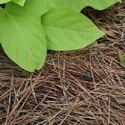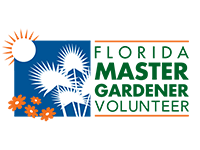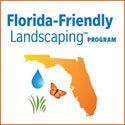Mulch Madness
(continued from page one)
Types of Mulch
When selecting a mulch, consider the following characteristics:
- Cost
- Color
- Origins
- Durability
- Nutrient Content
- Texture/Appearance
Here are some types you can choose from:
Pine bark is a byproduct of the forest industry. It comes in ground and nugget forms and has a rich brown color.
Pine straw (needles) comes from pine plantations, which produce paper and wood products. Unlike some mulches, pine needles are not likely to wash away because they knit together.
Fallen leaves (including grass clippings) can be raked up for free in your landscape. This type of mulch is high in nutrients but decomposes quickly.
Melaleuca mulch is made from the exotic invasive trees. The product is cured at a high temperature to kill the seeds so they won’t germinate in your garden.
Mixed hardwood mulch is produced from scrap lumber, recycled pallets, or tree stems too small for use in paper or wood production.
Eucalyptus mulch typically comes from plantations in South and Central Florida, where the trees are grown specifically for this purpose. They grow quickly, so this mulch is considered renewable.
Utility mulch is sold or given away for free by many utility companies. This mulch comes from trimming trees and other plants that get in the way of power lines; but be aware that it can come with weed seeds.
Cypress mulch is composed of both wood and bark. Cypress trees, which grow in Florida’s forested wetlands, are often harvested for lumber and used in fencing, flooring, furniture, and other products. Cypress mulch is often made from the waste wood generated in the manufacture of these products, but it may also come from whole trees cut from wetlands. The Florida-Friendly Landscaping Program does not recommend the use of cypress mulch, as its origins may be difficult to determine.
Gravel or pebbles can be used as mulch, but they won’t contribute to the soil’s nutrient content or water-holding capacity. If you use this type of mulch, make sure to first install a woven ground cloth to keep it from sinking into sandy soils. This mulch lasts a long time, but it will need to be cleared of debris to look its best.





